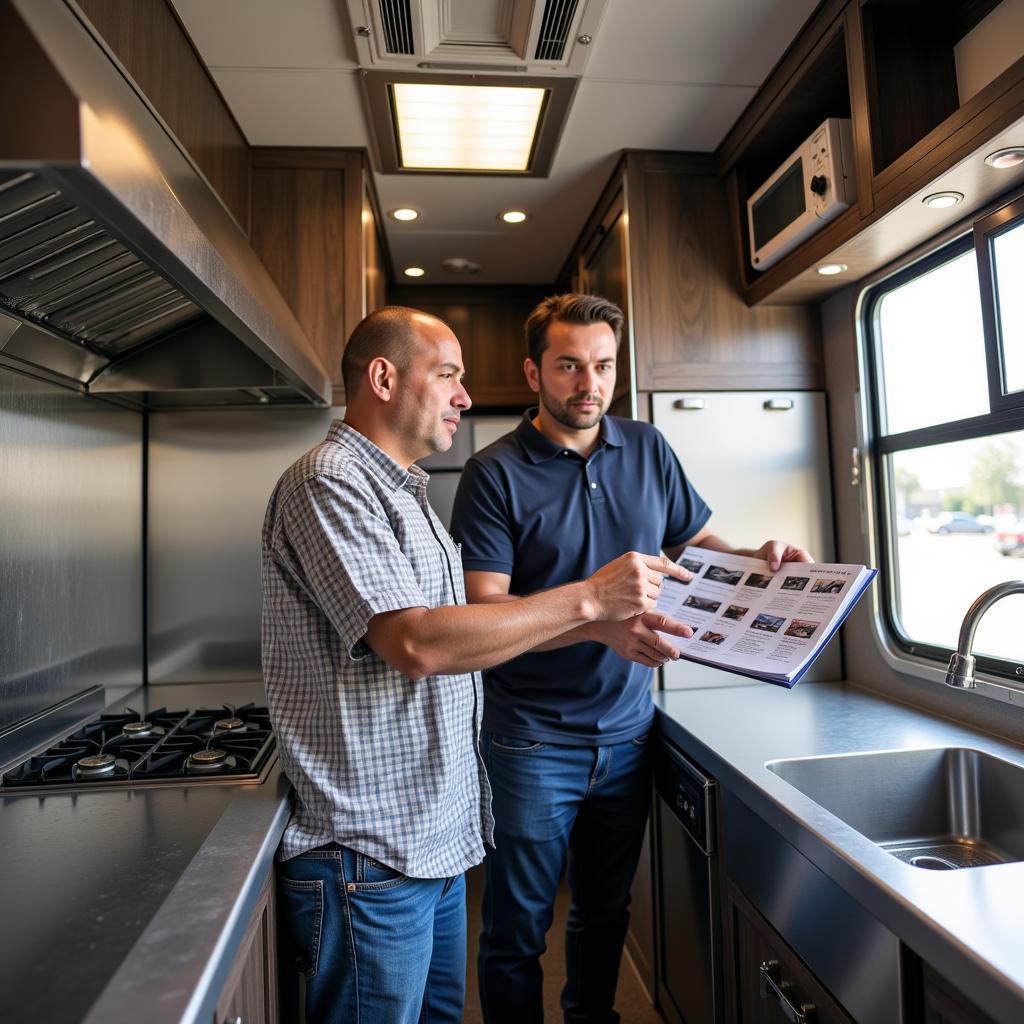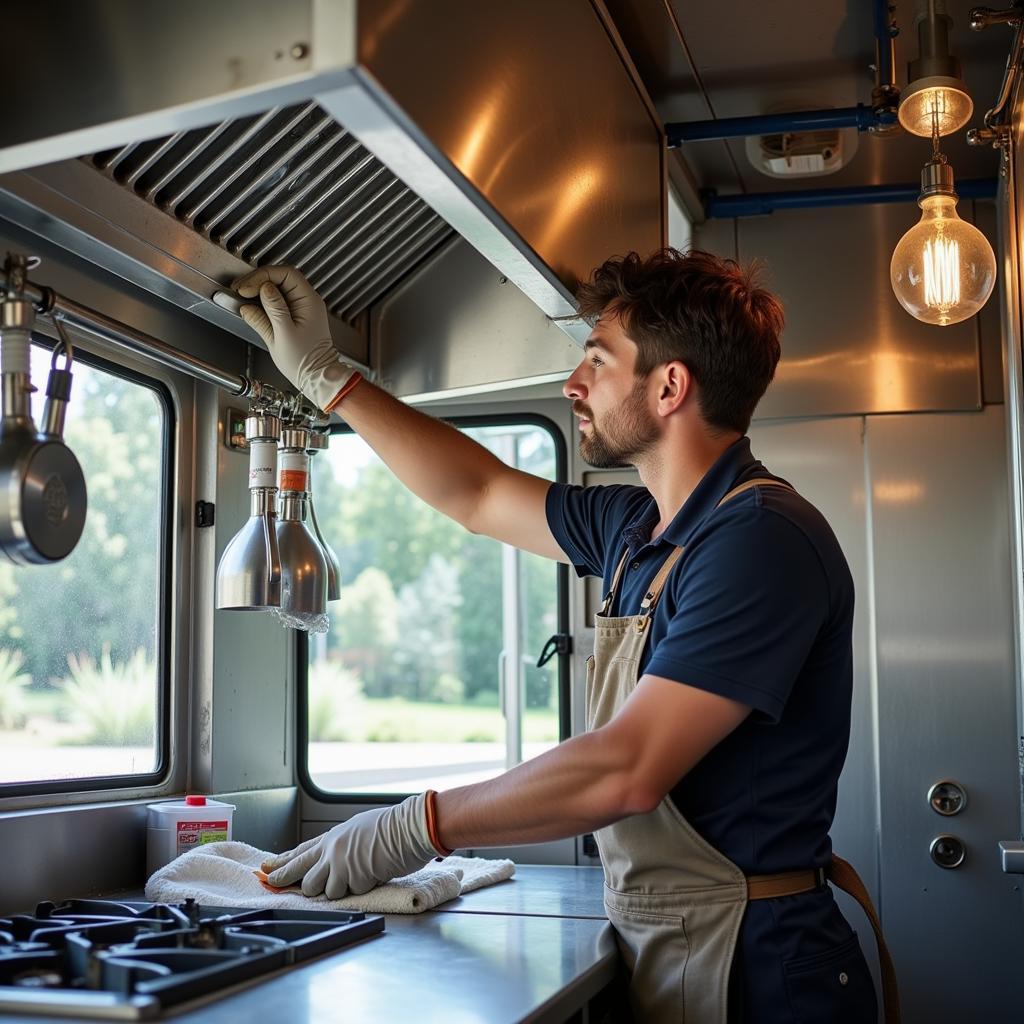A crucial part of any successful food truck business is a reliable and efficient Food Truck Hood System. This system is not just about keeping your kitchen cool, it’s about ensuring the safety of your staff, adhering to regulations, and creating a comfortable environment for cooking up those delicious meals your customers crave.
Why Your Food Truck Needs a Proper Hood System
Imagine this: you’re in the middle of the lunch rush, flipping burgers and tossing fries, when suddenly the air becomes thick with smoke. You can’t see, your eyes are stinging, and your customers are starting to worry. This is just one scenario a proper food truck hood system can prevent. Here’s why it’s non-negotiable:
- Safety First: A well-designed system removes smoke, grease, and heat from the cooking area, reducing the risk of fires and creating a safer environment for you and your staff.
- Code Compliance: Most municipalities have strict regulations regarding ventilation in food trucks. A compliant hood system ensures you’re meeting the legal requirements to operate.
- Improved Air Quality: By removing cooking odors and fumes, your food truck remains a pleasant place to work and dine, even during those busy rushes.
- Equipment Protection: A hood system helps protect your valuable cooking equipment from grease buildup and heat damage, extending its lifespan.
Key Components of a Food Truck Hood System
Choosing the right food truck hood system can feel overwhelming, but understanding the key components will help you make an informed decision:
- Hood: This is the visible part mounted above your cooking equipment. It captures smoke, grease, and heat. Hoods come in various styles and sizes to fit different kitchen layouts.
- Filters: These trap grease particles from the air, preventing them from entering the ductwork and reducing the risk of fire hazards.
- Fan: The powerhouse of the system, the fan pulls air and contaminants up through the hood and expels them outside.
- Ductwork: Connects the hood to the fan and then to the outside of the truck, creating a pathway for the exhaust to escape.
- Fire Suppression System: An essential safety feature that automatically activates in case of a fire, extinguishing flames within the hood and ductwork.
Factors to Consider When Choosing a Hood System
 Food Truck Owner Discussing Hood Options
Food Truck Owner Discussing Hood Options
Selecting the right food truck hood system for your needs depends on several factors:
- Cooking Style and Equipment: The type and quantity of cooking you do (grilling, frying, etc.) and the equipment you use will dictate the power and size of the system needed.
- Truck Size and Layout: The dimensions of your truck and the kitchen layout will impact the hood style, ductwork design, and fan placement.
- Local Regulations: Research local codes and regulations regarding ventilation requirements for food trucks in your area.
- Budget: Determine your budget and prioritize features that are essential for safety and compliance.
Maintenance: The Key to Longevity and Efficiency
A well-maintained food truck hood system will operate efficiently and safely for years to come. Follow these maintenance tips:
- Regular Cleaning: Clean filters, hood surfaces, and ductwork regularly to prevent grease buildup and maintain airflow.
- Professional Inspections: Schedule professional inspections and cleaning at least annually, or more frequently depending on usage, to ensure everything is in working order.
- Fan Maintenance: Regularly check the fan for any debris or damage and lubricate moving parts as needed.
 Food Truck Hood System Cleaning
Food Truck Hood System Cleaning
Invest in Your Success: Prioritize Your Hood System
A reliable food truck hood system is an investment in the safety of your team, the longevity of your equipment, and the overall success of your business. Don’t cut corners when it comes to this vital component. Consult with reputable suppliers, understand your needs, and make informed decisions that will keep your food truck kitchen running smoothly for years to come.
FAQs About Food Truck Hood Systems
Q: How often should I clean my food truck hood filters?
A: The frequency of filter cleaning depends on usage, but a good rule of thumb is to clean them at least once a week, or more often for high-volume cooking.
Q: Can I install a food truck hood system myself?
A: While it might seem tempting, it’s highly recommended to have your hood system professionally installed to ensure it meets safety standards and local codes.
Q: What is a fire suppression system and do I need one?
A: A fire suppression system is designed to automatically extinguish fires within the hood and ductwork. It’s a crucial safety feature and often required by regulations for food trucks.
Need Help with Your Food Truck Ventilation?
For all your food truck ventilation fan, food truck range hood, and overall ventilation system for food truck needs, explore the solutions offered at Mina Cones Food. We also have resources available for food trailer cabinets and insights into successful ventures like the Oink Joint food truck. Contact us today at 02437655121 or email [email protected]. Our team is available 24/7 to assist you at our location: 3PGH+8R9, ĐT70A, thôn Trung, Bắc Từ Liêm, Hà Nội, Việt Nam. We’re here to help you create a safe and efficient food truck kitchen.